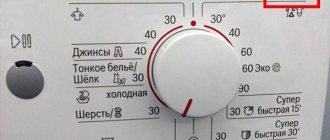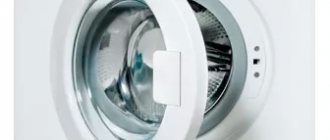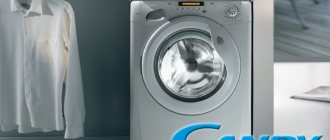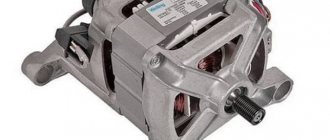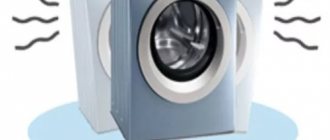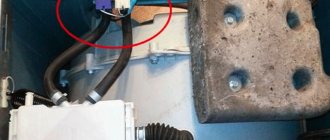About the basic washing programs of Veko options
- 40'40° - a twofold reduction in washing time - 40 minutes, not 80, which is facilitated by additional revolutions of the Beko machine drum and a constant temperature of 40 degrees;
- Delicate washing mode – for items made of knitwear and viscose, implying smooth drum movements. The program protects the material from abrasion and the color from fading;
- for children's clothing, several washing and rinsing cycles are combined; the regime is also optimal for the things of those who suffer from allergic reactions;
- a special program for dark fabrics involves low temperature and low spin speed with a large volume of water to protect things from possible shedding; For maximum effect, it is recommended to use detergent products in liquid form;
- For cashmere and silk, the Beko machine has a hand wash cycle that uses less water. This blocks increased moisture absorption of fabric fibers and protects them from deformation and stretching;
- The mode for woolen products allows for the most gentle care for them, protecting them from pilling and matting;
- mode for goods with down and feather fillings - for options with a drum capacity of 9 kilograms or more. Along with washing things, feather mites and their metabolic products are eliminated;
- The Beko washing machine's self-cleaning program treats the hoses, drum and detergent trays at a temperature of 70 degrees, removing mold;
- The shirt washing mode helps in washing problem areas of products without damaging the material; drum speeds maintain balance at a temperature of no more than 40 degrees;
- fitness program - for processing sportswear made of cotton and synthetics at a temperature of 40 degrees;
- eco 20°C – for items made of cotton fabrics with slight dirt. Saves up to 80% of energy when compared to a standard cotton cycle, and liquid or gel laundry products are the optimal solution.
Useful tips
The washing machine greatly simplifies a person’s life, and operating the machine is easier than it seems. If you follow the basic rules, the machine will last for many years without complaints or breakdowns. You just need to adhere to the following recommendations:
- do not neglect the instructions;
- For hard water, use a softener;
- do not change the mode during the washing process;
- leave the door open after the end of the cycle;
- Do not place heavy objects on the washing machine.
The first launch of Beko will go without surprises if you follow the instructions. The main thing is to prepare for the start and remember the manufacturer’s recommendations.
Interesting:
- Reviews of Beko dishwashers
- What is better washing machine Indesit or Beko?
- Beko washing machines
- Turning on the Beko washing machine
- How to use a Beko washing machine
- First launch of the Kandy washing machine
Reader comments
- Share your opinion - leave a comment
Beko washing machines: everything to save time
One of the most valuable resources in our life is time. Therefore, Beko washing machines have modes for quick and high-quality washing.
- Mini - for cotton with a minimum of dirt at 30 degrees and 39 minutes for a full tank; The temperature regime is performed manually from 0 to 90 degrees, which may affect the duration of the process.
- Mini 14´ - at temperatures from 0 to 30 degrees, the Beko washing machine will clean 2 kilograms of clothes in 14 minutes.
- A refreshing wash cycle of 17 minutes is ideal for lightly soiled items to add freshness and eliminate odors;
- Mix 40°C for every day - for options from various materials without sorting at 40 degrees.
The ratio of speed and quality is what active and business people value Veko products for!
Distinctive features of Beko washing machines
One of the significant advantages of this manufacturer’s products is ease of use. Unlike most other manufacturers, Beko uses virtually no icons on the control panel. All modes, all controls are signed in the language of the country to which the car is exported.
The correctness of this approach can be questioned, because icons take up less space and are often easier to read. But graphic images also have a significant drawback - the lack of standardization. Different manufacturers of washing machines use different icons, most often radically different from each other. When changing a device, owners have to get used to the changed markings for a long time, which is often difficult.
Veko washing machines: new times - new functions
In addition to generally accepted standards, new technologies have prompted Beko to develop new functions:
- mode to eliminate lint and pet hair by adding wash and rinse cycles;
- the necessary locking of the washing machine panels using special keys to avoid unexpected pressing, most often by children;
- aquafusion, which saves powder consumption by storing the latter in the drum of the Beko washing machine until the very end of the process;
- aquawave – electronic imbalance control for uniform placement of laundry in the tank;
- protection against power outages - automatic restart in case of power outages and resumption of washing at the interrupted place;
- a sensor to save from possible overflow, which reacts to exceeding the permissible water level in the tank of the Beko washing machine;
- half load mode – for a small amount of clothes. It is also important not to overdo it with the dosage of the detergent product;
- Silent tech™ technology – to reduce noise and spin during the washing process, reduce energy consumption and give a longer life cycle to the washing machine.
Thus, Veko washing machines are products that keep up with the times!
Functional set
In order to use the washing machine to the limit of its capabilities, it is better to get acquainted with the offered functionality in addition to the modes. The presence of special options will significantly facilitate and secure the washing process, which cannot but please consumers. Thus, VEKO compares favorably with several “tricks”:
- removal of lint and wool, for which a special mode is provided with an increased number of cycles and rinses;
- locking the panel from children and accidental pressing;
- aqua-fusion or economical consumption of detergent with uniform use of powder throughout the entire washing process;
- aquawave, also known as imbalance control, designed to evenly distribute laundry along the walls of the tank without lumps or ligaments;
- auto-restart of the started cycle after a power surge or power outage in the house;
- a touch sensor that monitors the water level in the tank to prevent overflow;
- half load, allowing you to wash a small amount of laundry faster and more economically.
Convenience and improving reliability are the secret to the success of Veko washing machines
The use of the Veko technique is very comfortable, thanks to several significant improvements:
- LCD display displaying water temperature, spin speed, cycle stage, remaining time until the end of the process, and other indicators;
- Volume hatch for loading, including large items - blankets and jackets;
- Expanded drum volume even with the miniature size of the Beko washing machine: with a depth of 35 cm - 5 kg. clothes, 40-45 cm - 6 and 7 kg., and with the standard - 8-9 kg.;
- A special tray for liquid laundry products, for use even with a delayed start;
- High-tech heating elements with revolutionary nickel protection, which reduces scaling and protects against corrosion processes.
Veko washing machines are thought out with precision down to the smallest detail!
Veko washing machines: deciphering error codes
Not every Veko washing machine has an error display; For some, one or another indicator lights up:
- H1 – faulty washing machine temperature sensor due to oxidation or damage to its contacts. To troubleshoot problems, test the thermistor wiring and measure the resistance. If information is displayed that differs greatly from the standard, the sensor must be replaced.
- H2 - display when a tubular electric heater malfunctions - the use of low-quality water with a considerable number of impurities that form scale on the heating element or drops in electrical voltage in the network.
- H3 – the heating element of the Beko washing machine remains in working condition and the set temperature is exceeded with the first and second indicator lights constantly burning. Problems with the temperature sensor or a control unit error cannot be ruled out.
- H4 – malfunction of the fill valve triac with the first and third indicators visible. Wiring condition monitoring is required; diagnosis of the latter is recommended.
- H5 – problems with the drain pump, as evidenced by the second and third lights being on. The pump is cleaned if clogged, or replaced if there are significant defects.
- H6 – closure of the triac with notification by the first three indicators. Apparently there was a short circuit in a section of the triac, then it is replaced. The integrity of the wiring of the unit elements, the control module and the electric motor of the Beko washing machine are also monitored; if necessary, the components are repaired or replaced.
- H7 – problems with the controller related to the liquid level with the first three indicators lighting up. Possible reasons are electrical locking of the hatch doors, a malfunction of the pressure switch or module, or simply a closed valve.
- H11 – problems with the motor circuit of the Beko machine. In this case, it is important to evaluate the condition of the tachogenerator, bearings, brushes or wiring. If all the mentioned actions do not lead to results, then testing the triac is necessary.
The error codes described above will help you independently identify breakdowns and eliminate their causes.
Is it possible to harm equipment?
The Beko automatic machine is actually quite easy to use. The main thing is to take into account the basic recommendations for operating the equipment. It is very important to read the instructions for a specific Beko washing machine model, understand the features of its control, and remember the basic rules.
A few tips for beginners:
- do not exceed the maximum permissible load weight, but also do not “drive” the machine with a practically empty drum;
- wipe the washing machine at the end of the cycle, leave the hatch open and the dispenser pulled out for ventilation;
- do not put anything on the machine;
- Do not try to adjust the cycle parameters after the equipment has filled with water and started washing. This may cause electronic failure;
- measure the degree of hardness of tap water and purchase detergents that will help avoid the formation of limescale on the “insides” of the washing machine.
Now it’s clear how to start washing on Beko automatic machines. It is important not only to install and connect the equipment correctly, but also to follow basic recommendations for further operation: do not overload the equipment, select the washing mode based on the laundry being placed in the drum, and buy high-quality detergents.
Interesting:
- Where are the transport bolts of the Zanussi washing machine?
- Reviews of Beko dishwashers
- First launch of the Beko washing machine
- How to remove shipping bolts on a washing machine...
- How to use the Atlant washing machine?
- Ariston washing machine makes noise when spinning
Reader comments
- Share your opinion - leave a comment

